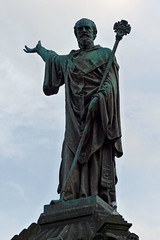Council of Bari 1098
 The Council of Bari took place in October 1098. Presided over by pope Urban II in Bari, on the Adriatic Sea in southern Italy. Bari had recently been captured from the Byzantines (1071) and was a stronghold in Norman-controlled southern Italy. Pope Urban II was touring the region to strengthen papal authority, to push church reform, and deal with disputes between the Western (Latin) and Eastern (Greek) Churches. It was attended by 185 bishops, from both the Catholic and Orthodox traditions, including Archbishop Anselm of Canterbury, who was in exile from England at the time.
The Council of Bari took place in October 1098. Presided over by pope Urban II in Bari, on the Adriatic Sea in southern Italy. Bari had recently been captured from the Byzantines (1071) and was a stronghold in Norman-controlled southern Italy. Pope Urban II was touring the region to strengthen papal authority, to push church reform, and deal with disputes between the Western (Latin) and Eastern (Greek) Churches. It was attended by 185 bishops, from both the Catholic and Orthodox traditions, including Archbishop Anselm of Canterbury, who was in exile from England at the time.
The central theological debate was with Greek bishops (representing the Byzantine Church) over the clause Filioque (“and the Son”) in the Nicene Creed. The Latin Church taught that the Holy Spirit proceeds from the Father and the Son. Whilst the Greek Church rejected the addition of “and the Son,” holding that the Holy Spirit proceeds from the Father alone. This dispute arose from the Council of Toledo in 589 so that in the Latin church the creed read
We believe in the Holy Spirit,
the Lord, the giver of life,
who proceeds from the Father and the Son
whilst in the Greek church it read
And in the Holy Spirit, the Lord and life-giver,
Who proceeds from the Father
The Latin church had inserted "and the son" into the Creed without an ecumenical council, and the Greek church objected to the insertion both on the theology and to the unilateral change without discussion.
This was a major theological symbol of deeper divides. Rome claimed universal jurisdiction over all Christians, whilst Constantinople and the Eastern patriarchs rejected papal supremacy, insisting on a collegial model of authority. Also the use of leavened (Greek) vs. unleavened (Latin) bread in the Eucharist. The different clerical disciplines (celibacy in West, married parish priests in East), and the use of Latin vs. Greek.
Thus though the Filioque was one of the main theological flashpoints of the Great Schism, it wasn’t the sole cause, but the controversy symbolized the irreconcilable differences between the two Churches.. The deeper roots of the Schism lay in the authority of Pope vs. Patriarchs and East–West cultural estrangement. Which culminating in 1054 with the mutual excommunications (Cardinal Humbert vs. Patriarch Michael Cerularius) crystallized centuries of tension.
Anselm argued that the Father and the Son share the same divine essence, and therefore, the Spirit, who proceeds from the Father, must also proceed from the Son, since the Son is fully God with the Father. He then described the Holy Spirit as the mutual love (or gift) shared between the Father and the Son. So if the Spirit were to proceed from the Father alone, this unity of love between Father and Son would not be fully expressed. Anselm stressed that the Father remains the principle without principle (the ultimate source). But the Son shares in the Father’s eternal generation and divinity, so the Spirit’s procession is from both together, not separately.
Anselm cited passages such as John 15:26 (“the Spirit of truth who proceeds from the Father, whom I will send to you”) to show that Scripture links both Father and Son in sending the Spirit, and also pointed to Latin Church Fathers (like Augustine of Hippo) who taught the Filioque implicitly.
The Greek bishops at Bari were not convinced, and the controversy was not resolved. However, Anselm’s arguments were highly respected in the West and later expanded in his treatise De Processione Spiritus Sancti (“On the Procession of the Holy Spirit”), written soon after the council.
